monish
AH elite
Maneating Tigers of India
Although humans are not regular prey for them, the tiger has killed more people than any other cat. Between 1800 and 1900, it is estimated that tigers had killed over 10,000 people in India alone, coinciding with the wave of British settlement. However, man-eaters are mostly old and injured tigers, and almost all tigers that are identified as man-eaters are eventually captured, shot or poisoned. Man-eaters have been a recurrent problem for India, especially in Kumaon, Garhwal and the Sundarbans mangrove swamps of Bengal, where some healthy tigers have been known to hunt humans.

Man Killer Tiger
Because many of the south Asian subspecies of tiger, particularly the Bengal tiger in Bangladesh and India, live in areas of high and growing population density, farmers and loggers have a long and continuing history of encroaching on tiger habitat, increasing the probability of confrontation. The number of tigers as a whole has dwindled in the twenty-first century, partly due to indiscriminate poaching.
Reasons for attacking
Tigers are sometimes intimidated from attacking humans, especially if they are unfamiliar with people. Unlike man-eating leopards, even established man-eating tigers will seldom enter human settlements, usually sticking to village outskirts. Nevertheless, attacks in human villages do occur.
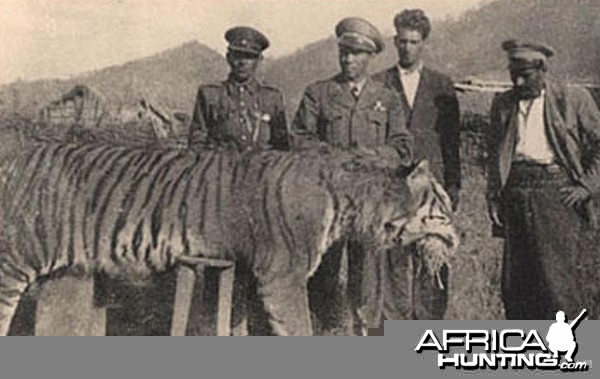
Man-eater Tiger
Tigers are typically wary of humans and have shown no preference for human meat. Although humans are relatively easy prey, they are not a desired source of food. Most tigers will only attack a human if they cannot physically satisfy their needs otherwise. Thus, most man-eating tigers are old, infirm or have missing teeth. In one case, a post-mortem examination of a killed tigress revealed two broken canine teeth, four missing incisors and a loose upper molar, handicaps which make capturing more standard prey extremely difficult. Only once reaching this stage did she attack a workman.
Taste for human flesh may be acquired by the consumption of corpses which have lain unburied. During the Vietnam and Korean wars, soldiers became the victims of tigers who had acquired a taste for human flesh in this way. Tigers will stalk groups of people bending down while working in a field or cutting grass, but will lose interest as soon as the people stand upright. Consequently, it has been hypothesized that some attacks are a simple case of mistaken identity.
Tigers typically surprise victims from the side or from behind: either approaching upwind or lying in wait downwind. Tigers rarely press an attack if they are seen before their ambush is mounted.

Early 1900's stereoview photo of famous Man-eater at Calcutta, devoured 200 men, women and children before being captured - India.
Kenneth Anderson once commented on man eating tigers
"It is extraordinary how very cautious every man-eater becomes by practice, whether a tiger or panther, and cowardly too. Invariably, it will only attack a solitary person, and that too, after prolonged and painstaking stalking, having assured itself that no other human being is in the immediate vicinity... These animals seem also to possess an astute sixth sense and be able to differentiate between an unarmed human being and an armed man deliberately pursuing them, for in most cases, only when cornered will they venture to attack the latter, while they go out of their way to stalk and attack the unarmed man."
Champawat Tiger
One notorious man-eating tigress, known as the Champawat Tigress, killed some 200 men and women before being driven out of Nepal. She moved to another location, this time in India, and continued to kill, bringing her total up to 436 before she was tracked down and killed in 1911. She was known to enter villages, even during daylight, roaring and causing people to flee in panic to their huts.
The Champawat Tigress was extremely cunning, as man-eaters usually are. She was found by Jim Corbett because he followed the trail of blood the tigress left behind after killing her last victim, a 16-year-old girl. Later examination of the tigress showed the upper and lower canine teeth on the right side of her mouth were broken—the upper one in half, the lower one right down to the bone. This permanent injury, Corbett claimed, "had prevented her from killing her natural prey, and had been the cause of her becoming a man-eater.

Man-eater Champawat Tiger
Tigers of Chowgarh
The Tigers of Chowgarh were a pair of man-eating Bengal tigers, consisting of an old tigress and her sub-adult cub, which for over a five year period killed a reported 64 people in eastern Kumaon over an area spanning 1,500 square miles. The figures however are uncertain, as the natives of the areas the tigers frequented claimed double that number, and they do not take into account victims who survived direct attacks but died subsequently. Both tigers were killed by Jim Corbett.

Chowgarh Man-eater Tiger
Tiger of Mundachipallam
The Tiger of Mundachipallam was a male Bengal tiger which killed 7 people in the vicinity of the village of Pennagram, four miles from the Hogenakkal Falls. Unlike the Champawat man-eater, the Mundachipallam tiger had no infirmities preventing it from hunting its natural prey. Its first three victims were killed in unprovoked attacks, while the subsequent victims were devoured. The Mundachipallam tiger was later killed by Kenneth Anderson.
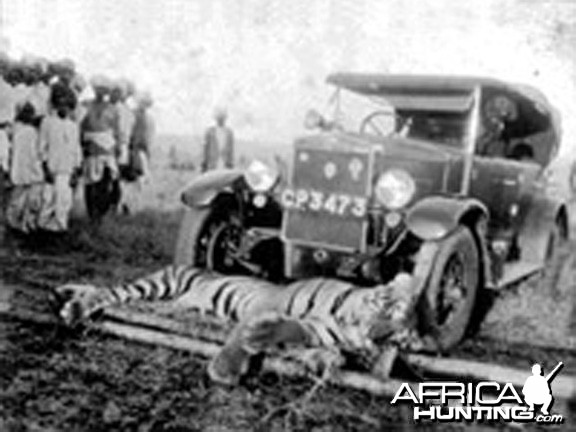
The Sundarbans
The Bengal tigers of the Sundarbans (translation: 'beautiful forest'), bordering India and Bangladesh, used to regularly kill fifty or sixty people a year. This was strange given that the tigers were usually in prime condition and had adequate prey available. Approximately 600 tigers live in this region, possible the largest single population anywhere in the world.The kill rate has dropped significantly due to better management techniques and now only about three people lose their lives each year. Despite the notoriety associated with this area, humans are only a supplement to the tiger's diet; they do not provide a primary food source.

Man-eater of Bhimashankar
A story was discovered by Pune-based author Sureshchandra Warghade when he ran into an old villager in the Bhimashankar forest which lies near Pune. The villager explained to the author how a man-eating tiger terrorized the entire Bhimashakar area during a span of two years in the 1940s. This villager was a police constable in that area and he had been responsible for dealing with the formalities surrounding the deaths (missing person reports and death certificates) and other jobs such as helping the hunting parties. During this time the tiger supposedly killed more than 100 people, but it was apparently very careful to avoid discovery; only 2 bodies were ever found. Several hunting parties were organized but the only one to succeed was an Ambegaon-based hunter named Ismail. During his first attempt, Ismail had a direct confrontation with the tiger and was almost killed, but returned to eliminate the man-eater. The tiger predominately killed the villagers who slept outside the huts.
The authenticity of the story told by the villager was confirmed when Warghade examined official reports, including a certificate given by the British authorities for killing the man-eating tiger.
Tara of the Dudhwa National Park
While the Sundarbans are particularly well-known throughout the world for its tiger attacks, Dudhwa National Park also had several man-eaters in the late 1970s. The first death was on 2 March 1978, closely followed by 3 further kills.
The population demanded action from authorities. As is usual in cases of this type, the natives wanted the man-eater shot or poisoned. The killings continued, each one making headlines. Officials soon started to believe that the likely culprit was a tigress called Tara. Conservationist Billy Arjan Singh had taken the British-born cat from Twycross Zoo and raised her in India, with the goal of releasing her back into the wild. His experiments had also been carried out on leopards with some success.
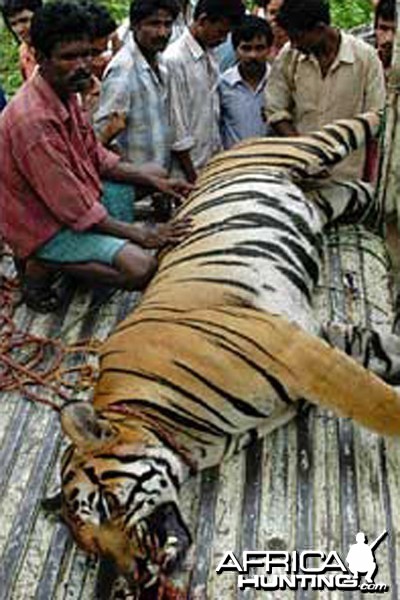
Experts felt that Tara would not have the required skills and correct hunting techniques to survive in the wild and controversy surrounded the project. She also associated men with providing food and comfort, which increased the likelihood that she would approach villages.
Officials later became convinced that Tara had taken to easier prey and become a man-eater. A total of 24 people were killed before the tigress was shot. Singh also joined the hunt with the intent of identifying the man-eater, but firm confirmation of the identity of the tiger was never found.
The debate over the tiger's identity has continued in the years since the attacks. Singh's supporters continue to claim that the tiger was not Tara, and the conservationist has produced evidence to that effect. However, officials maintain that the tiger was definitely Tara.
Other man-eaters from Dudhwa National Park have existed, but this tiger remains the most famous man-eater of the reserve because she was potentially the first captive-bred tiger to be trained and released into the wild. This controversy cast doubt on the success of Singh's rewilding project.
Problems at Dudhwa have been minor in the past few years. Occasional tiger attacks still occur, but these are no higher than at other wildlife reserves. On average, two villagers are attacked at Ranthambhore Tiger Reserve each year. These attacks generally occur during the monsoon season when the locals enter the reserve to collect grass.
Man-eater of Changa Nala
This magnificent male tiger, known as "Big Terror", was killed in the village of Changa Nala in northern India close to the border with Nepal. The tiger had wandered over a large area of India for several years, killing at least eight and perhaps as many as a dozen people. Travelers on the road, walking or on bicycle, wood cutters and forest guards - no one was safe.
Dr. Denver Coleman of Pasadena, California, hunted and eventually killed this tiger in 1969.

Changa Nala Man-eater Tiger
Tigress of Jowlagiri
The Tigress of Jowlagiri was a man-eating Bengal tigress responsible for the deaths of 15 people over an area extending Jowlagiri in the extreme north, to Gundalam 30 miles to the south; and from the borders of Mysore State to the west. She was killed by Kenneth Anderson.
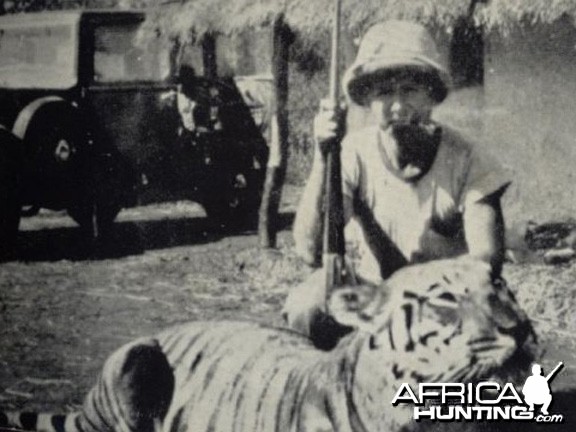
Kenneth Anderson with Man-eater of Jowlagiri
The Tiger of Segur
It was a young man-eating male Bengal tiger. Though originating in the District of Malabar-Wynaad below the south-western face of the Blue Mountains, the tiger would later shift its hunting grounds to Gudalur and between Segur and Anaikutty. It was killed by Kenneth Anderson, who would later note that the tiger had a disability preventing it from hunting its natural prey.
Upon examining the carcass, Anderson noted that the tiger had one eye, the other having been badly damaged by a shotgun slug.
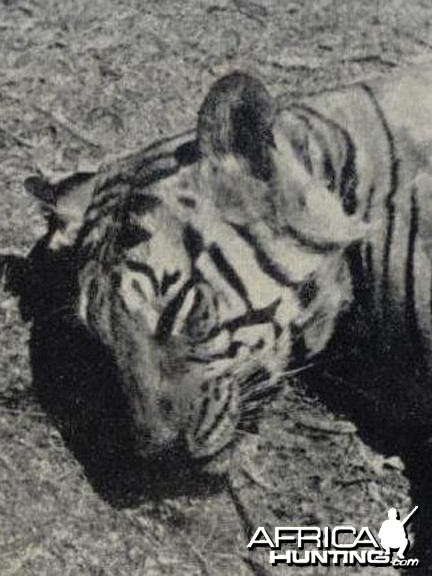
Man-eater of Segur
These were few of the maneating tigers which had horrifying celebrity status in India.
Monish
Although humans are not regular prey for them, the tiger has killed more people than any other cat. Between 1800 and 1900, it is estimated that tigers had killed over 10,000 people in India alone, coinciding with the wave of British settlement. However, man-eaters are mostly old and injured tigers, and almost all tigers that are identified as man-eaters are eventually captured, shot or poisoned. Man-eaters have been a recurrent problem for India, especially in Kumaon, Garhwal and the Sundarbans mangrove swamps of Bengal, where some healthy tigers have been known to hunt humans.
Man Killer Tiger
Because many of the south Asian subspecies of tiger, particularly the Bengal tiger in Bangladesh and India, live in areas of high and growing population density, farmers and loggers have a long and continuing history of encroaching on tiger habitat, increasing the probability of confrontation. The number of tigers as a whole has dwindled in the twenty-first century, partly due to indiscriminate poaching.
Reasons for attacking
Tigers are sometimes intimidated from attacking humans, especially if they are unfamiliar with people. Unlike man-eating leopards, even established man-eating tigers will seldom enter human settlements, usually sticking to village outskirts. Nevertheless, attacks in human villages do occur.
Man-eater Tiger
Tigers are typically wary of humans and have shown no preference for human meat. Although humans are relatively easy prey, they are not a desired source of food. Most tigers will only attack a human if they cannot physically satisfy their needs otherwise. Thus, most man-eating tigers are old, infirm or have missing teeth. In one case, a post-mortem examination of a killed tigress revealed two broken canine teeth, four missing incisors and a loose upper molar, handicaps which make capturing more standard prey extremely difficult. Only once reaching this stage did she attack a workman.
Taste for human flesh may be acquired by the consumption of corpses which have lain unburied. During the Vietnam and Korean wars, soldiers became the victims of tigers who had acquired a taste for human flesh in this way. Tigers will stalk groups of people bending down while working in a field or cutting grass, but will lose interest as soon as the people stand upright. Consequently, it has been hypothesized that some attacks are a simple case of mistaken identity.
Tigers typically surprise victims from the side or from behind: either approaching upwind or lying in wait downwind. Tigers rarely press an attack if they are seen before their ambush is mounted.
Early 1900's stereoview photo of famous Man-eater at Calcutta, devoured 200 men, women and children before being captured - India.
Kenneth Anderson once commented on man eating tigers
"It is extraordinary how very cautious every man-eater becomes by practice, whether a tiger or panther, and cowardly too. Invariably, it will only attack a solitary person, and that too, after prolonged and painstaking stalking, having assured itself that no other human being is in the immediate vicinity... These animals seem also to possess an astute sixth sense and be able to differentiate between an unarmed human being and an armed man deliberately pursuing them, for in most cases, only when cornered will they venture to attack the latter, while they go out of their way to stalk and attack the unarmed man."
Champawat Tiger
One notorious man-eating tigress, known as the Champawat Tigress, killed some 200 men and women before being driven out of Nepal. She moved to another location, this time in India, and continued to kill, bringing her total up to 436 before she was tracked down and killed in 1911. She was known to enter villages, even during daylight, roaring and causing people to flee in panic to their huts.
The Champawat Tigress was extremely cunning, as man-eaters usually are. She was found by Jim Corbett because he followed the trail of blood the tigress left behind after killing her last victim, a 16-year-old girl. Later examination of the tigress showed the upper and lower canine teeth on the right side of her mouth were broken—the upper one in half, the lower one right down to the bone. This permanent injury, Corbett claimed, "had prevented her from killing her natural prey, and had been the cause of her becoming a man-eater.
Man-eater Champawat Tiger
Tigers of Chowgarh
The Tigers of Chowgarh were a pair of man-eating Bengal tigers, consisting of an old tigress and her sub-adult cub, which for over a five year period killed a reported 64 people in eastern Kumaon over an area spanning 1,500 square miles. The figures however are uncertain, as the natives of the areas the tigers frequented claimed double that number, and they do not take into account victims who survived direct attacks but died subsequently. Both tigers were killed by Jim Corbett.
Chowgarh Man-eater Tiger
Tiger of Mundachipallam
The Tiger of Mundachipallam was a male Bengal tiger which killed 7 people in the vicinity of the village of Pennagram, four miles from the Hogenakkal Falls. Unlike the Champawat man-eater, the Mundachipallam tiger had no infirmities preventing it from hunting its natural prey. Its first three victims were killed in unprovoked attacks, while the subsequent victims were devoured. The Mundachipallam tiger was later killed by Kenneth Anderson.
The Sundarbans
The Bengal tigers of the Sundarbans (translation: 'beautiful forest'), bordering India and Bangladesh, used to regularly kill fifty or sixty people a year. This was strange given that the tigers were usually in prime condition and had adequate prey available. Approximately 600 tigers live in this region, possible the largest single population anywhere in the world.The kill rate has dropped significantly due to better management techniques and now only about three people lose their lives each year. Despite the notoriety associated with this area, humans are only a supplement to the tiger's diet; they do not provide a primary food source.
Man-eater of Bhimashankar
A story was discovered by Pune-based author Sureshchandra Warghade when he ran into an old villager in the Bhimashankar forest which lies near Pune. The villager explained to the author how a man-eating tiger terrorized the entire Bhimashakar area during a span of two years in the 1940s. This villager was a police constable in that area and he had been responsible for dealing with the formalities surrounding the deaths (missing person reports and death certificates) and other jobs such as helping the hunting parties. During this time the tiger supposedly killed more than 100 people, but it was apparently very careful to avoid discovery; only 2 bodies were ever found. Several hunting parties were organized but the only one to succeed was an Ambegaon-based hunter named Ismail. During his first attempt, Ismail had a direct confrontation with the tiger and was almost killed, but returned to eliminate the man-eater. The tiger predominately killed the villagers who slept outside the huts.
The authenticity of the story told by the villager was confirmed when Warghade examined official reports, including a certificate given by the British authorities for killing the man-eating tiger.
Tara of the Dudhwa National Park
While the Sundarbans are particularly well-known throughout the world for its tiger attacks, Dudhwa National Park also had several man-eaters in the late 1970s. The first death was on 2 March 1978, closely followed by 3 further kills.
The population demanded action from authorities. As is usual in cases of this type, the natives wanted the man-eater shot or poisoned. The killings continued, each one making headlines. Officials soon started to believe that the likely culprit was a tigress called Tara. Conservationist Billy Arjan Singh had taken the British-born cat from Twycross Zoo and raised her in India, with the goal of releasing her back into the wild. His experiments had also been carried out on leopards with some success.
Experts felt that Tara would not have the required skills and correct hunting techniques to survive in the wild and controversy surrounded the project. She also associated men with providing food and comfort, which increased the likelihood that she would approach villages.
Officials later became convinced that Tara had taken to easier prey and become a man-eater. A total of 24 people were killed before the tigress was shot. Singh also joined the hunt with the intent of identifying the man-eater, but firm confirmation of the identity of the tiger was never found.
The debate over the tiger's identity has continued in the years since the attacks. Singh's supporters continue to claim that the tiger was not Tara, and the conservationist has produced evidence to that effect. However, officials maintain that the tiger was definitely Tara.
Other man-eaters from Dudhwa National Park have existed, but this tiger remains the most famous man-eater of the reserve because she was potentially the first captive-bred tiger to be trained and released into the wild. This controversy cast doubt on the success of Singh's rewilding project.
Problems at Dudhwa have been minor in the past few years. Occasional tiger attacks still occur, but these are no higher than at other wildlife reserves. On average, two villagers are attacked at Ranthambhore Tiger Reserve each year. These attacks generally occur during the monsoon season when the locals enter the reserve to collect grass.
Man-eater of Changa Nala
This magnificent male tiger, known as "Big Terror", was killed in the village of Changa Nala in northern India close to the border with Nepal. The tiger had wandered over a large area of India for several years, killing at least eight and perhaps as many as a dozen people. Travelers on the road, walking or on bicycle, wood cutters and forest guards - no one was safe.
Dr. Denver Coleman of Pasadena, California, hunted and eventually killed this tiger in 1969.
Changa Nala Man-eater Tiger
Tigress of Jowlagiri
The Tigress of Jowlagiri was a man-eating Bengal tigress responsible for the deaths of 15 people over an area extending Jowlagiri in the extreme north, to Gundalam 30 miles to the south; and from the borders of Mysore State to the west. She was killed by Kenneth Anderson.
Kenneth Anderson with Man-eater of Jowlagiri
The Tiger of Segur
It was a young man-eating male Bengal tiger. Though originating in the District of Malabar-Wynaad below the south-western face of the Blue Mountains, the tiger would later shift its hunting grounds to Gudalur and between Segur and Anaikutty. It was killed by Kenneth Anderson, who would later note that the tiger had a disability preventing it from hunting its natural prey.
Upon examining the carcass, Anderson noted that the tiger had one eye, the other having been badly damaged by a shotgun slug.
Man-eater of Segur
These were few of the maneating tigers which had horrifying celebrity status in India.
Monish
Last edited by a moderator:

